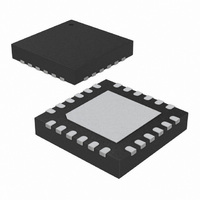ATA5771-PXQW Atmel, ATA5771-PXQW Datasheet - Page 123

ATA5771-PXQW
Manufacturer Part Number
ATA5771-PXQW
Description
XMITTR UHF ASK/FSK 868MHZ 24VQFN
Manufacturer
Atmel
Datasheet
1.ATA5773-DK1.pdf
(219 pages)
Specifications of ATA5771-PXQW
Frequency
868MHz ~ 928MHz
Modulation Or Protocol
UHF
Power - Output
8dBm
Voltage - Supply
2 V ~ 4 V
Current - Transmitting
9.8mA
Data Interface
PCB, Surface Mount
Memory Size
4kB Flash, 256B EEPROM, 256B SRAM
Antenna Connector
PCB, Surface Mount
Operating Temperature
-40°C ~ 85°C
Package / Case
24-VQFN Exposed Pad, 24-HVQFN, 24-SQFN, 24-DHVQFN
Processor Series
ATA5x
Core
AVR8
Data Bus Width
8 bit
Program Memory Type
Flash
Program Memory Size
4 KB
Data Ram Size
256 B
Interface Type
SPI, USI
Maximum Clock Frequency
4 MHz
Number Of Programmable I/os
12
Number Of Timers
2
Maximum Operating Temperature
+ 85 C
Mounting Style
SMD/SMT
Minimum Operating Temperature
- 40 C
On-chip Adc
10 bit, 12 Channel
Lead Free Status / RoHS Status
Lead free / RoHS Compliant
Applications
-
Sensitivity
-
Data Rate - Maximum
-
Current - Receiving
-
Lead Free Status / Rohs Status
Details
Available stocks
Company
Part Number
Manufacturer
Quantity
Price
Company:
Part Number:
ATA5771-PXQW
Manufacturer:
ATMEL
Quantity:
218
- Current page: 123 of 219
- Download datasheet (4Mb)
4.17
4.17.1
4.17.1.1
9137E–RKE–12/10
Timer/Counter Prescaler
Prescaler Reset
External Clock Source
Timer/Counter 0, and 1 share the same prescaler module, but the Timer/Counters can have
different prescaler settings. The description below applies to all Timer/Counters. Tn is used as
a general name, n = 0, 1.
The Timer/Counter can be clocked directly by the system clock (by setting the CSn2:0 = 1).
This provides the fastest operation, with a maximum Timer/Counter clock frequency equal to
system clock frequency (f
used as a clock source. The prescaled clock has a frequency of either f
f
The prescaler is free running, i.e., operates independently of the Clock Select logic of the
Timer/CounterCounter, and it is shared by the Timer/Counter Tn. Since the prescaler is not
affected by the Timer/Counter’s clock select, the state of the prescaler will have implications
for situations where a prescaled clock is used. One example of prescaling artifacts occurs
when the timer is enabled and clocked by the prescaler (6 > CSn2:0 > 1). The number of sys-
tem clock cycles from when the timer is enabled to the first count occurs can be from 1 to N+1
system clock cycles, where N equals the prescaler divisor (8, 64, 256, or 1024).
It is possible to use the Prescaler Reset for synchronizing the Timer/Counter to program
execution.
An external clock source applied to the Tn pin can be used as Timer/Counter clock (clk
Tn pin is sampled once every system clock cycle by the pin synchronization logic. The syn-
chronized (sampled) signal is then passed through the edge detector.
functional equivalent block diagram of the Tn synchronization and edge detector logic. The
registers are clocked at the positive edge of the internal system clock (
transparent in the high period of the internal system clock.
The edge detector generates one clk
(CSn2:0 = 6) edge it detects.
Figure 4-50. T0 Pin Sampling
The synchronization and edge detector logic introduces a delay of 2.5 to 3.5 system clock
cycles from an edge has been applied to the Tn pin to the counter is updated.
Enabling and disabling of the clock input must be done when Tn has been stable for at least
one system clock cycle, otherwise it is a risk that a false Timer/Counter clock pulse is
generated.
CLK_I/O
Tn
/256, or f
clk
I/O
CLK_I/O
D
LE
Q
/1024.
Synchronization
CLK_I/O
D
Q
). Alternatively, one of four taps from the prescaler can be
T
0
pulse for each positive (CSn2:0 = 7) or negative
Atmel ATA5771/73/74
D
Q
Edge Detector
Figure 4-50
CLK_I/O
clk
I/O
). The latch is
/8, f
Tn_sync
(To Clock
Select Logic)
CLK_I/O
shows a
Tn
). The
/64,
123
Related parts for ATA5771-PXQW
Image
Part Number
Description
Manufacturer
Datasheet
Request
R

Part Number:
Description:
BOARD XMITTER FOR ATA5771 868MHZ
Manufacturer:
Atmel
Datasheet:

Part Number:
Description:
Manufacturer:
ATMEL Corporation
Datasheet:

Part Number:
Description:
DEV KIT FOR AVR/AVR32
Manufacturer:
Atmel
Datasheet:

Part Number:
Description:
INTERVAL AND WIPE/WASH WIPER CONTROL IC WITH DELAY
Manufacturer:
ATMEL Corporation
Datasheet:

Part Number:
Description:
Low-Voltage Voice-Switched IC for Hands-Free Operation
Manufacturer:
ATMEL Corporation
Datasheet:

Part Number:
Description:
MONOLITHIC INTEGRATED FEATUREPHONE CIRCUIT
Manufacturer:
ATMEL Corporation
Datasheet:

Part Number:
Description:
AM-FM Receiver IC U4255BM-M
Manufacturer:
ATMEL Corporation
Datasheet:

Part Number:
Description:
Monolithic Integrated Feature Phone Circuit
Manufacturer:
ATMEL Corporation
Datasheet:

Part Number:
Description:
Multistandard Video-IF and Quasi Parallel Sound Processing
Manufacturer:
ATMEL Corporation
Datasheet:

Part Number:
Description:
High-performance EE PLD
Manufacturer:
ATMEL Corporation
Datasheet:

Part Number:
Description:
8-bit Flash Microcontroller
Manufacturer:
ATMEL Corporation
Datasheet:

Part Number:
Description:
2-Wire Serial EEPROM
Manufacturer:
ATMEL Corporation
Datasheet:











